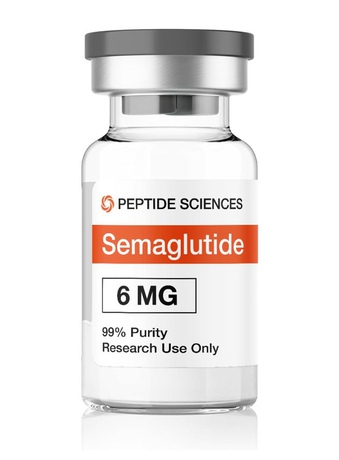Semaglutide is a derivative of naturally occurring GLP-1, a peptide known to lower blood sugar and increase insulin secretion. Studies show that semaglutide can also improve the function of the heart, liver, and lungs, helping to slow down or prevent the effects of Alzheimer's disease. It has been shown that semaglutide significantly reduces appetite, delaying gastric emptying and reducing intestinal peristalsis. It has been shown that an analog of glucagon-like peptide-1 (GLP-1) stimulates insulin and suppresses glucagon secretion in a glucose-dependent manner.
Review of semaglutide and GLP-1
GLP-1, short for glucagon-like peptide-1, is a short natural peptide hormone with a length of only 30-31 amino acids.
Its main physiological function — decrease in blood sugar level due to natural enhancement of insulin secretion. It also plays a role in protecting insulin reserves in beta cells, promoting the transcription of the insulin gene, and is associated with neurotrophic effects in the brain and central nervous system. It has been shown that in the gastrointestinal system, GLP-1 significantly reduces appetite, delaying gastric emptying and reducing intestinal peristalsis. Preliminary studies have shown the effect of GLP-1 on the heart, fat, muscles, bones, liver, lungs and kidneys.
The main focus of GLP-1 research has been on the treatment/prevention of diabetes, as well as appetite suppression. Secondary studies are focused on the potential benefits of the peptide for the cardiovascular system. More recent and, therefore, less reliable studies are focused on the ability of GLP-1 to prevent neurodegenerative diseases. Although this latter area of research is newer, it is also a rapidly growing area of GLP-1 research now that the peptide has been found to slow or prevent the accumulation of beta-amyloid plaques in Alzheimer's disease.
Research of semaglutide and GLP-1 Incretin effect of GLP-1
Perhaps the most important effect that GLP-1 has, according to Dr. Holst, is called the "incretin effect". Incretins are a group of metabolic hormones that are released by the gastrointestinal tract and cause a decrease in the level of glucose (sugar) in the blood. It was shown that GLP-1 is one of the two most important hormones (the second - GIP) stimulating the incretin effect in rodent models. Although GIP circulates at levels approximately 10 times higher than GLP-1, there is evidence that GLP-1 is the more potent of the two molecules, especially when blood glucose levels are quite high
The GLP-1 receptor has been identified on the surface of pancreatic beta cells, suggesting that GLP-1 directly stimulates exocytosis of insulin from the pancreas. It has been shown that in combination with sulfonylurea drugs, GLP-1 increases insulin secretion so much that it causes mild hypoglycemia in 40% of subjects.
Of course, increased insulin secretion is associated with a number of trophic effects, including increased protein synthesis, decreased protein breakdown, and increased uptake of amino acids by skeletal muscle.
GLP-1 and protection of beta cells
Studies in animal models show that GLP-1 can stimulate the growth and proliferation of pancreatic beta cells and that it can stimulate the differentiation of new beta cells from progenitors in the pancreatic ductal epithelium.
Studies have also shown that GLP-1 inhibits beta cell apoptosis.
Together, these effects tip the normal balance of beta cell growth and death toward growth, which suggests that the peptide may be useful in the treatment of diabetes and in the protection of the pancreas from damage that damages beta cells.
In one particularly convincing study, it was shown that GLP-1 inhibits the death of beta cells caused by an increased level of inflammatory cytokines. In fact, mouse models of type 1 diabetes have shown that GLP-1 protects islet cells from destruction and may actually be a useful means of preventing type 1 diabetes.
Potential benefits of GLP-1 for the cardiovascular system
It is now known that GLP-1 receptors are distributed throughout the heart and under certain conditions improve cardiac function, increasing heart rate and reducing end-diastolic pressure in the left ventricle. The latter may seem insignificant, but an increase in LV end-diastolic pressure is associated with LV hypertrophy, cardiac remodeling, and possible heart failure.
Recent data have even shown that GLP-1 may play a role in reducing the overall damage caused by a heart attack. It seems that the peptide improves the absorption of glucose by the heart muscle, thereby helping to fight ischemic heart muscle cells to obtain the nutrition they need to continue functioning and prevent programmed cell death. The increase in glucose uptake by these cells apparently does not depend on insulin.
It was shown that large injections of GLP-1 in dogs improve LV function and reduce systemic vascular resistance. The latter effect can help reduce blood pressure and, as a result, ease the burden on the heart. This, in turn, can help reduce the long-term consequences of high blood pressure, such as LV remodeling, vessel thickening, and heart failure. According to Dr. Holst, administration of GLP-1 after cardiac trauma "consistently improves myocardial performance both in experimental animal models and in patients".



